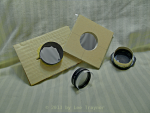Youtube Video
With the camera now functioning like it cost ten times the price thanks to the possibilities of CHDK, it was time to look at a couple of hardware issues.
Filters. A polarisation filter is a major game-changer, as anyone wearing polarised sunglasses can tell, because it cuts down reflection from water and glassy surfaces and thus also the haze in the air that washes out detail at large distances. With a pol filter the sky is bluer, the grass is greener, and the hills are closer. The only trouble is attaching filters to digital cameras, which often don’t come with a thread or other mounting device.
For very small cameras (such as the A470) there is a magnetic solution, whereby a ring magnet is stuck onto the end of the lens and the filter attaches to the ring; however, filter size is limited to a diameter of 22 mm. For the other cameras whose lens barrel has a diameter of 43 mm, another solution had to be found. PVC plumbing is too wide but the inner diameter can be reduced by gluing small pieces of rubber onto the inside. Another solution is to use a yoghurt cup and cut it down to the right size. Fits snugly, holds the filter robustly and is very lightweight. Watch the video:
Tripod. Since weight is key when tramping, I’ll be using a much lighter tripod than the recent two trips. With the help of CHDK’s grid I’ll be able to check that I’m on the level; and for the rest a panoramic tripod head is not worth the bother. To minimise parallax, make sure there’s not too much scenery up close.
Memory Card. Important for minimising cloud movement in bracketed shots is the class of SDHC card; the Canons seem to have a limit themselves of writing at about 10 MB/s, so that anything less than class 10 will delay subsequent shots. I have tried cards that claim to write at 45 MB/s, but the camera just won’t keep up. If cloud movement is an issue, then I could also try shooting plain JPGs, rather than RAW.
Batteries. Again, with the help of CHDK, it was possible to design a standard test for batteries whereby the camera takes a shot a minute until the battery runs out; the number of shots = the number of minutes the camera operated. The surprising result was that lower-rated eneloop brand batteries (1900 mAh) operated for as long as higher-rated brands (up to 2700 mAh, both at around 200 shots/charge). Furthermore, if the batteries were tested three days after being fully charged, the eneloop batteries still performed at their usual strength, whereas some of the other brands started to fail completely. If batteries do not work three days after charging, throw them away.
Power Supply. And for the all night astrophotography an imitation Canon power supply is much cheaper than the original and just as good. I have operated some of these devices for months on end.
Hardware is set to go.

